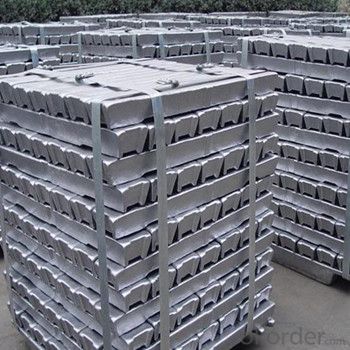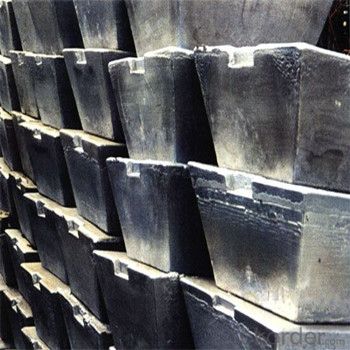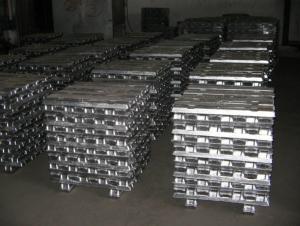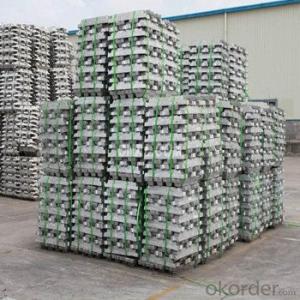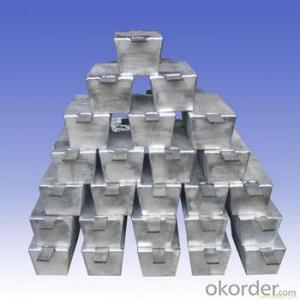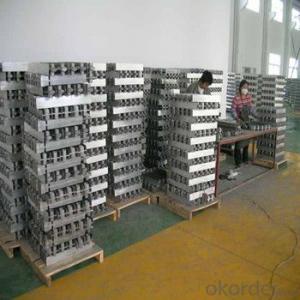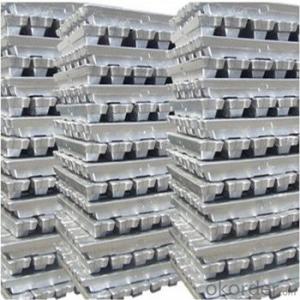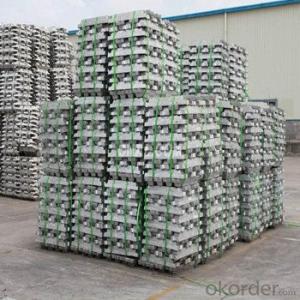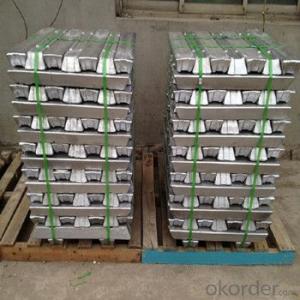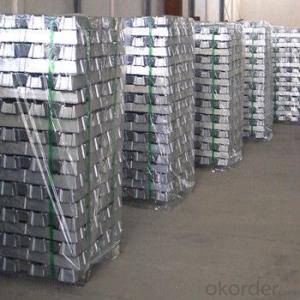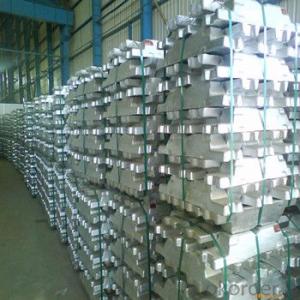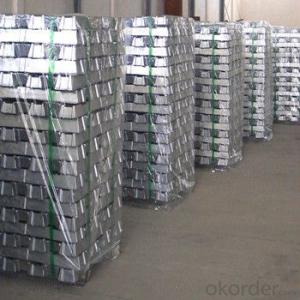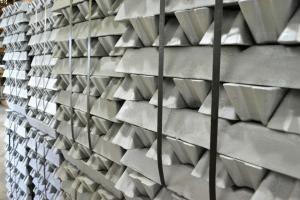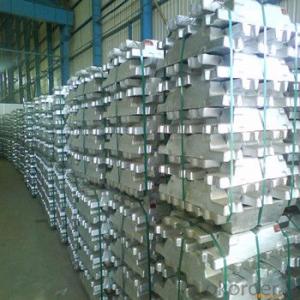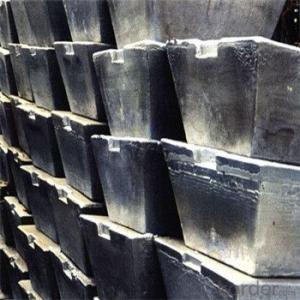Aluminum Pig/Ingot With Mills From China
- Loading Port:
- China main port
- Payment Terms:
- TT OR LC
- Min Order Qty:
- 1000 m.t.
- Supply Capability:
- 100000 m.t./month
OKorder Service Pledge
OKorder Financial Service
You Might Also Like
Pure Aluminum Pig/Ingot Used for Industry
1.Structure of Aluminum Pig/Ingot
A material that has been cast into a shape in order to be transported and processed easier than in an unprocessed form. An ingot is typically rectangular in shape, which allows it to be stacked. Ingots are most commonly associated with metals, with ingots of gold held in the vaults of banks and brokerages being popular images.
Aluminum Ingot is with the AL as the main chemical composition.Aluminum Ingot is used for industry,such as automobile,pinning and weaving,electron broadly and so on. Aluminum Ingot has the following advantages: easy control and operation, fast melting.
2.Main Features of the Aluminum Pig/Ingot
•High Purity
•Easy control and operation
•High strength
•Fast melting
•Competitive price
•Best Service
3.Aluminum Pig/Ingot Images
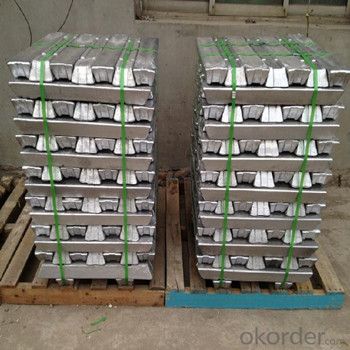
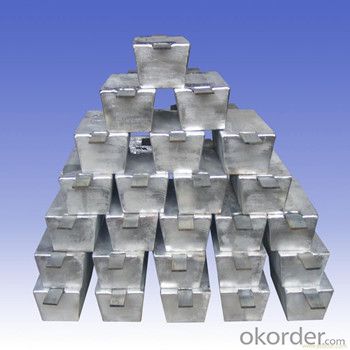
4.Aluminum Pig/Ingot Specification
Grade | Chemical Composition % | |||||||||
Al≥ | impurities ≤ | |||||||||
Si | Fe | Cu | Ga | Mg | Zn | Mn | others | Sum | ||
Al99.9 | 99.90 | 0.50 | 0.07 | 0.005 | 0.02 | 0.01 | 0.025 | - | 0.010 | 0.10 |
Al99.85 | 99.85 | 0.80 | 0.12 | 0.005 | 0.03 | 0.02 | 0.030 | - | 0.015 | 0.15 |
Al99.7 | 99.70 | 0.10 | 0.20 | 0.010 | 0.03 | 0.02 | 0.030 | - | 0.030 | 0.30 |
Al99.6 | 99.60 | 0.16 | 0.25 | 0.010 | 0.03 | 0.03 | 0.030 | - | 0.030 | 0.40 |
Al99.5 | 99.50 | 0.22 | 0.30 | 0.020 | 0.03 | 0.05 | 0.050 | - | 0.030 | 0.50 |
Al99.00 | 99.00 | 0.42 | 0.50 | 0.020 | 0.03 | 0.05 | 0.050 | - | 0.050 | 1.00 |
5.FAQ of Aluminum Pig/Ingot
We have organized several common questions for our clients,may help you sincerely:
①How about your company?
A reliable manufacturer & supplier of Aluminum Pig/Ingot,with many years’ experience in producing Aluminum Pig/Ingot.The items have beedn exported around the world,and have been acceptable among the customers,and have gotten the good reputation already.No matter from the quality,price and service,can be guaranteed for the cusgtomers.High purity and diffent grade are available.
②How to guarantee the quality of the products?
We have established the international advanced quality management system,every link from raw material to final product we have strict quality test;We resolutely put an end to unqualified products flowing into the market. At the same time, we will provide necessary follow-up service assurance.
③How long can we receive the product after purchase?
In the purchase of product within three wo We have organized several common questions for our clients,may help you sincerely:
- Q: What are the different coating processes for aluminum ingots?
- There are several different coating processes for aluminum ingots, including anodizing, powder coating, electroplating, and chemical conversion coating.
- Q: What is the weight of a standard aluminum ingot?
- The weight of a standard aluminum ingot can vary depending on its size and dimensions. However, a common standard for aluminum ingots is around 22.5 kilograms or 50 pounds.
- Q: What's the difference between aluminium ingot A380 and ADC12?
- Two kinds of material are different, mainly reflected in the silicon content above, A380 is the number of ADC12 is made, day number.
- Q: How are aluminum ingots used in the production of cookware?
- Aluminum ingots play a crucial role in the production of cookware due to their unique properties. These ingots are melted down and then shaped into desired cookware forms, such as pots, pans, and baking sheets. One of the main reasons aluminum is widely used in cookware production is its excellent heat conductivity. Aluminum conducts heat more efficiently than other metals, which ensures even heat distribution across the entire surface of the cookware. This property allows for consistent cooking results, preventing hotspots and reducing the risk of food burning or sticking to the pan. Moreover, aluminum is lightweight and easy to handle, making it a popular choice for cookware. This feature is particularly beneficial for individuals with limited strength or mobility, as it enables them to maneuver and lift the cookware without much effort. However, pure aluminum is relatively soft and susceptible to scratches and dents. To improve its durability, aluminum ingots are often alloyed with other metals, such as copper or stainless steel, during the cookware manufacturing process. These alloys enhance the strength and hardness of the cookware while retaining the excellent heat conductivity of aluminum. Additionally, aluminum is non-reactive, meaning it does not interact with acidic or alkaline foods. This characteristic ensures that the taste and quality of the cooked food are not affected by the cookware material. Furthermore, aluminum cookware is generally affordable, making it accessible to a wide range of consumers. Its cost-effectiveness, combined with its excellent cooking performance, has made aluminum cookware a staple in many kitchens around the world. In conclusion, aluminum ingots are indispensable in the production of cookware due to their excellent heat conductivity, lightweight nature, and non-reactive properties. By utilizing aluminum ingots, manufacturers can create cookware that provides even heat distribution, durability, and affordability to enhance the cooking experience for consumers.
- Q: What are the different cutting techniques for aluminum ingots?
- There are several cutting techniques that can be used for aluminum ingots, depending on the desired outcome and the specific application. 1. Bandsaw cutting: This method involves using a bandsaw machine with a specialized blade to cut through the aluminum ingot. Bandsaw cutting is commonly used for large-scale production as it allows for high precision and accuracy in cutting. 2. Circular saw cutting: Circular saws equipped with carbide-tipped blades can also be used to cut aluminum ingots. This method is suitable for both small-scale and large-scale cutting operations, offering a relatively fast cutting speed. 3. Waterjet cutting: Waterjet cutting uses a high-pressure stream of water mixed with an abrasive material to cut through the aluminum ingot. This technique is ideal for precise and intricate cuts as it does not generate heat, minimizing the risk of thermal distortion. 4. Plasma cutting: Plasma cutting involves using a plasma torch to melt and cut through the aluminum ingot. It is a versatile cutting method that can be used for various thicknesses and shapes. 5. Laser cutting: Laser cutting utilizes a highly focused laser beam to melt and vaporize the aluminum, creating a clean and precise cut. This technique is particularly effective for thin aluminum ingots. 6. Shearing: Shearing is a cutting technique that involves applying a shearing force to the aluminum ingot, typically using a guillotine-style machine. This method is suitable for cutting thicker ingots and can be used for both straight and curved cuts. Each cutting technique has its advantages and limitations, and the choice of method depends on factors such as the desired cut quality, speed, complexity of the shape, and available equipment. It is recommended to consult with experts or professionals in the field to determine the most suitable cutting technique for a specific application.
- Q: What are the advantages of using aluminum ingots in electrical applications?
- There are several advantages of using aluminum ingots in electrical applications. Firstly, aluminum is a lightweight material, which makes it easier to handle and transport. This property is particularly beneficial in electrical applications where weight is a concern, such as in the construction of power lines or in the manufacturing of electrical appliances. Secondly, aluminum has excellent electrical conductivity. It conducts electricity almost twice as well as copper, which is commonly used in electrical applications. This high conductivity allows for efficient transmission of electricity and reduces energy losses in electrical systems. Another advantage of aluminum ingots is their corrosion resistance. Aluminum forms a protective oxide layer when exposed to air, which helps to prevent corrosion. This makes aluminum suitable for use in outdoor electrical applications, where exposure to moisture or harsh weather conditions is common. Furthermore, aluminum is a highly recyclable material. It can be melted down and reused multiple times without losing its properties. This not only reduces the need for mining and extraction of new raw materials but also contributes to the sustainability of electrical applications. Lastly, aluminum ingots are cost-effective compared to other materials like copper or steel. Aluminum is abundant in nature and its extraction and processing are relatively less expensive, making it a more affordable option for electrical applications. Overall, the advantages of using aluminum ingots in electrical applications include their lightweight nature, high electrical conductivity, corrosion resistance, recyclability, and cost-effectiveness. These properties make aluminum a preferred choice in various electrical systems, contributing to improved efficiency, durability, and environmental sustainability.
- Q: What are the different surface finishes available for aluminum ingots?
- The different surface finishes available for aluminum ingots include mill finish, brushed finish, anodized finish, powder-coated finish, and polished finish.
- Q: How to calculate the price with or without ticket in the aluminum ingot trade? Does the invoice price increase with aluminum?
- The difference between the price of the ticket and the price without the ticket is between the price of the ticket and the price of the ticket without the price of the ticket.
- Q: What are the different testing methods for aluminum ingots?
- There are several testing methods used for aluminum ingots, including chemical analysis, mechanical testing, visual inspection, and non-destructive testing. Chemical analysis involves determining the composition of the alloy through techniques like spectroscopy or X-ray fluorescence. Mechanical testing includes tensile testing, hardness testing, and impact testing to evaluate the mechanical properties of the ingots. Visual inspection involves examining the ingots for any visible defects or irregularities. Non-destructive testing methods such as ultrasonic testing or radiographic testing are used to detect internal defects or inconsistencies without damaging the ingots.
- Q: How are aluminum ingots used in the production of power transmission towers?
- Aluminum ingots are used in the production of power transmission towers due to their lightweight and high strength properties. These ingots are melted down to create aluminum alloys, which are then cast into various components of the towers such as lattice structures, cross arms, and braces. The lightweight nature of aluminum makes it an ideal material for power transmission towers as it reduces the overall weight of the structure, making it easier and more cost-effective to transport and install. This is particularly advantageous in areas with difficult terrains or remote locations. Moreover, aluminum alloys offer excellent corrosion resistance, ensuring the longevity and durability of the power transmission towers. They can withstand harsh weather conditions, including extreme temperatures, humidity, and exposure to saltwater or chemicals. Additionally, aluminum ingots are highly malleable, allowing for easy fabrication and customization of tower components to meet specific design requirements. This flexibility enables engineers to create intricate lattice structures that can support heavy loads while maintaining stability. Aluminum's electrical conductivity is another key factor in its use for power transmission towers. It allows for efficient transmission of electricity with minimal power loss. This is crucial in maintaining the reliability and efficiency of the power grid. Overall, aluminum ingots play a vital role in the production of power transmission towers by providing lightweight, corrosion-resistant, and electrically conductive materials. Their use contributes to the construction of reliable, durable, and cost-effective infrastructure for transmitting electricity across long distances.
Send your message to us
Aluminum Pig/Ingot With Mills From China
- Loading Port:
- China main port
- Payment Terms:
- TT OR LC
- Min Order Qty:
- 1000 m.t.
- Supply Capability:
- 100000 m.t./month
OKorder Service Pledge
OKorder Financial Service
Similar products
Hot products
Hot Searches




